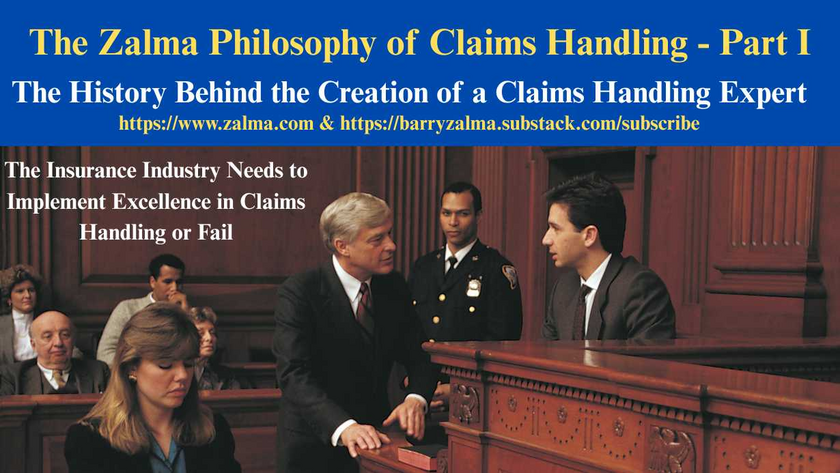
Why Did Insurer Ignore Evidence of Arson?
Read the full article at https://www.linkedin.com/pulse/arson-profit-proved-circumstantial-evidence-barry-zalma-esq-cfe and at https://zalma.com/blog plus more than 4100 posts.
Posted on March 10, 2022 by Barry Zalma
This criminal case stems from a 2015 fire at Adcor Industries for which the owner, Demetrios Stavrakis, collected a $15 million insurance payout. Suspicions arose when surveillance video showed Stavrakis tampering with the security system at the front entrance of the building on the evening of the fire. A seven-week jury trial ended in convictions on all counts. The district court found that the circumstantial evidence against Stavrakis was sufficient to support his convictions, and rejected a claim that the jury had been improperly instructed on willful blindness. In United States Of America v. Demetrios Stavrakis, a/k/a Dimitrios Stavrakis, a/k/a Jimmy, Nos. 20-4149, 20-4184, United States Court of Appeals, Fourth Circuit (February 24, 2022) the 15 year sentence was affirmed.
FACTS
This case began with a fire in the early morning hours of July 29, 2015, at a building in Baltimore, Maryland. The building housed Adcor Industries, owned by defendant Stavrakis, a precision parts business serving the beverage, aerospace, firearms, and defense industries. Investigators soon established that the fire was set intentionally, with the ignition of a drum of methanol in an interior office. The fire also appeared to be an inside job since there was no sign of forced entry, nothing was stolen, and the arsonist disarmed the alarm with the four-digit alarm code.
Nobody was injured in the fire. But the building was damaged and Adcor’s insurer, Travelers Indemnity Company of America, ignored the evidence against Stavrakis, its insured, and paid an approximately $15 million claim. Some of that money was used to repair the premises and to buy upgraded equipment and machinery. One repair claim, in particular, would become the subject of a separate fraud charge against Stavrakis: a $30,000 claim for a modern security system to replace Adcor’s previous and outdated system, which had sustained only modest damage in the clean-up after the fire. Stavrakis also used insurance proceeds to pay off private loans and, as the evidence later would reveal, to purchase luxury items including cars, a motorcycle, watches, and jewelry.
Surveillance video later showed, however, that Stavrakis in fact did lock up and set the alarm on the evening of the fire, and that he had used the opportunity to tamper with an ID-card reader at the front door. He was arrested and brought to trial in US District Court. A lengthy and complex jury trial commenced on September 9, 2019. Consuming close to seven weeks, the trial featured the testimony of approximately 60 witnesses and the introduction of roughly 700 exhibits.
It was undisputed that the Adcor fire was the product of arson. The government’s theory of the case was not that Stavrakis himself had set the fire – Stavrakis was at home when the fire was reported at approximately 1:30 a.m. on July 29, 2015 – but that he had worked with an accomplice, aiding and abetting the arson in order to collect insurance proceeds. To establish motive, the government introduced “voluminous evidence” that Adcor had been in dire financial straits since 2010, when it lost a lucrative contract with a major customer.
Central to the government’s case against Stavrakis was the surveillance video – played for the jury – that showed him tampering with the security system at Adcor’s front door on the evening before the fire. The government’s evidence showed, Stavrakis took the unusual step of inviting the last employee in the office to join him for dinner. One minute after she left the building for the restaurant, Stavrakis went directly to the main entrance. There, a video camera captured him putting tape on the latch of the door before setting the security alarm, disabling a locking mechanism that required entrants to swipe an ID card. Stavrakis then tested his work, exiting the building and reentering without swiping his own card.
Sure enough, although Adcor’s alarm was disarmed with the four-digit code later that night – first in the lobby, at 12:25 a.m., and then on the shop floor, at 12:33 a.m. – there was no record of an ID card being used to enter the building. Nor was surveillance video from that critical time ever found. Adcor employee Michael Hyatt testified that the relevant hard drives crashed and then, after they were set aside, were lost. In fact, many key pieces of evidence disappeared in the wake of the fire: Shortly after Stavrakis was called to the scene, the tape formerly observed on the front door was removed, as evidenced by a photograph of the door taken early that morning. And less than a month later – before investigators had reviewed the surveillance video showing Stavrakis at the door – the front office doors themselves were discarded and replaced.
The jury convicted Stavrakis on all counts.
ANALYSIS
Circumstantial Evidence
Arsonists seldom confess nor are they dumb enough to set a fire on camera. Therefore, most arson trials are based upon circumstantial evidence.
The trial court, of course, recognized at the outset that the government’s case against Stavrakis was circumstantial. But circumstantial evidence, the court explained, is treated no differently than direct evidence in assessing its sufficiency. So long as the evidence, viewed in the light most favorable to the government, could be accepted by a reasonable finder of fact as sufficient to support a verdict of guilt beyond a reasonable doubt, the jury’s verdict must be sustained.
Stavrakis’s primary argument: that the “central” evidence in the case – the video showing him tampering with the security system at the front door – was irrelevant because “there was no actual evidence to support the pivotal conclusion that the arsonist entered through the front door” and not through a hatch on the building’s roof or some other door. The court found, however, from which a reasonable jury could infer that the arsonist entered through the front door, including the fact that the alarm was disarmed first, at 12:25 a.m., in the lobby area immediately adjacent to that door. There also was the “irrefutabl[e]” fact that Stavrakis had taped the front door, and had done so before he attempted to set the alarm – so before he could have experienced the sensor alignment problem that he used to excuse his actions. A reasonable jury, the court finished, did not have to accept a “wildly speculative” “roof hatch scenario,” which would have had the arsonist using a ladder, on a public street, to climb onto the roof and through a hatch that evidence showed could not be opened from the outside.
In sum, the jury had before it a compelling case – circumstantial, but compelling – from which it could find, beyond a reasonable doubt, that Stavrakis knowingly participated in the arson. The proper focus is “the totality of the evidence,” which in this case was sufficient to support a guilty verdict.
After denying Stavrakis’s motions, the district court sentenced him to a total of fifteen years’ imprisonment. Stavrakis timely appealed his convictions.
Argument
A jury may make reasonable inferences from circumstantial evidence and for the reasons carefully detailed by the district court, “substantial evidence” in this case supported a reasonable inference of guilt. Viewed in the light most favorable to the government, the evidence is not in equipoise [A situation in which things are perfectly balanced]. As the district court found, the voluminous evidence introduced over the course of this seven-week trial, taken as a whole, made a substantial and “compelling” case against the defendant.
Stavrakis argued it was wrong to submit a willful blindness instruction. The Fourth Circuit concluded that such an instruction was warranted where “the defendant asserts a lack of guilty knowledge” – as Stavrakis does in connection with the handling of the $30,000 claim – but the evidence supports an inference of deliberate ignorance. It is not enough, in other words, that a defendant should have known, but for mere negligence or recklessness, that he was involved in a crime.
Where the evidence indicates that a defendant purposely closed his eyes to avoid knowing what was taking place around him, then a willful blindness instruction properly allows the jury to impute the element of knowledge.
ZALMA OPINION
With such damning evidence it is amazing that Travelers paid Stavrakis $15 million without, at least, reviewing the available evidence, without collecting the video that the government collected, and without taking the examination under oath of Stavrakis to inquire about the motives he had for the fire. Regardless, the government should be commended for putting on a thorough and evidence heavy trial that should have been collected by the insurer. Hopefully they sought restitution as the victim of the fire.
© 2022 – Barry Zalma
Barry Zalma, Esq., CFE, now limits his practice to service as an insurance consultant specializing in insurance coverage, insurance claims handling, insurance bad faith and insurance fraud almost equally for insurers and policyholders.
He practiced law in California for more than 44 years as an insurance coverage and claims handling lawyer and more than 54 years in the insurance business.
Subscribe to “Zalma on Insurance” at https://zalmaoninsurance.locals.com/subscribe and “Excellence in Claims Handling” at https://barryzalma.substack.com/welcome.
You can contact Mr. Zalma at https://www.zalma.com, https://www.claimschool.com, [email protected] and [email protected] . Mr. Zalma is the first recipient of the first annual Claims Magazine/ACE Legend Award.
You may find interesting the podcast “Zalma On Insurance” at https://anchor.fm/barry-zalma; you can follow Mr. Zalma on Twitter at; you should see Barry Zalma’s videos on https://www.youtube.com/channel/UCysiZklEtxZsSF9DfC0Expg/featured; or videos on https://rumble.com/zalma. Go to the Insurance Claims Library – https://zalma.com/blog/insurance-claims–library/ The last two issues of ZIFL are available at https://zalma.com/zalmas-insurance-fraud-letter-2/
Like
Comment
Share
When Harm is Inherent in the Nature of the Act it is Intentional
Post 5237
See the video at and at and at https://zalma.com/blog plus more than 5200 posts.
No Coverage for Intentional Acts
Hitting a Person in the Face is an Intentional Act
In Unitrin Auto and Home Insurance Company v. Brian C. Sullivan, et al., George A. Ciminello, No. 2022-01607, Index No. 21632/14, Supreme Court of New York, Second Department (November 19, 2025) George A. Ciminello was injured when struck in the face by a cup filled with liquid, thrown from a moving vehicle operated by Brian C. Sullivan, with Robert Harford as the passenger who threw the cup. The vehicle approached Ciminello at about 30 mph, from 2 to 10 feet away, and Harford extended his arm to make contact. The cup splintered upon impact.
Sullivan and Harford later conceded liability on the intentional tort claim before a damages trial.
Insurance Policy:
Unitrin Auto and Home...
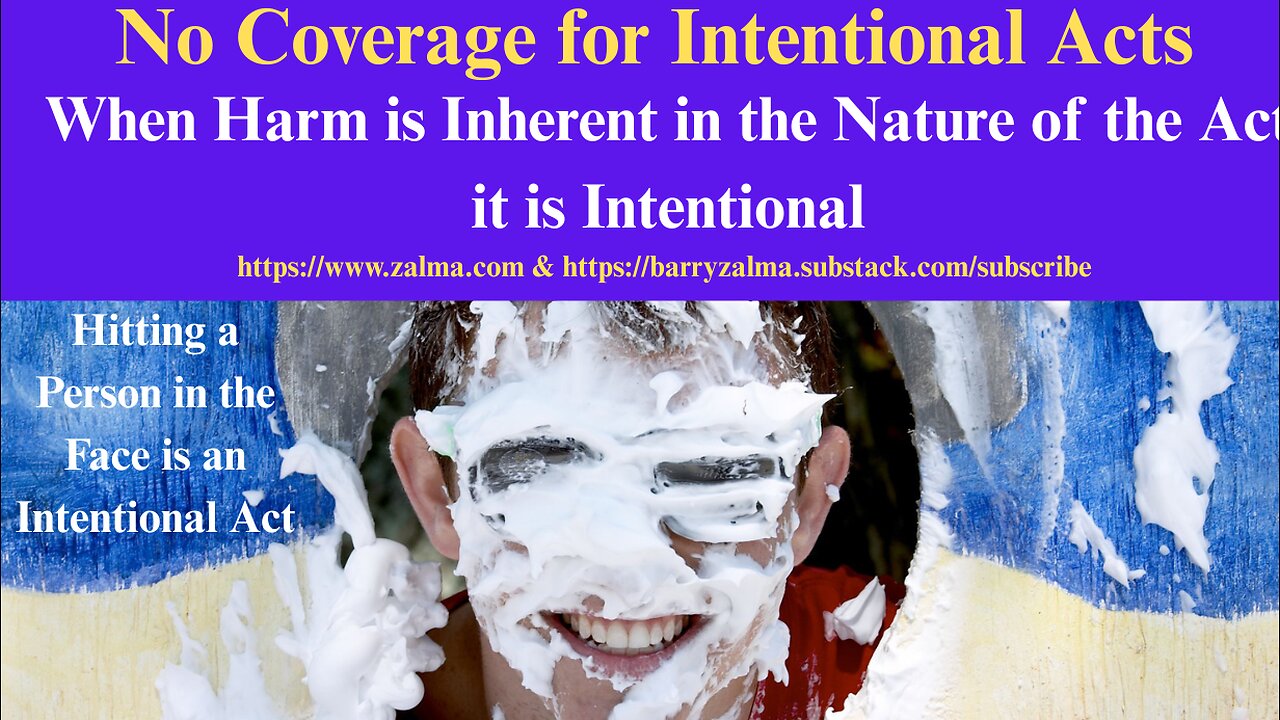
Obtaining Title to Church by Fraud Defeated
Post 5238
Read the full article at https://www.linkedin.com/pulse/unmitigated-gall-abuse-elderly-bishop-his-church-zalma-esq-cfe-xcasc, see the video at and at and at https://zalma.com/blog plus more than 5200 posts.
It is Villainous to Steal Church Property from Sick and Elderly Bishop
In Testimonial Cathedral Local Church of God in Christ v. EquityKey Real Estate Option, LLC et al. (Cal. Ct. App., 2d Dist., Div. 8, No. B331522 (Nov. 18, 2025) EquityKey (through broker Steven Sharpe and Frank Wheaton, a trusted advisor/friend of elderly Bishop Jimmy Hackworth) presented a deal supposedly for a $4 million life-insurance policy on Hackworth’s life with EquityKey as beneficiary. In exchange, EquityKey paid Hackworth $400,000 upfront.
Factual Background
To qualify Hackworth for the large policy, church real property on South Western Ave., Los Angeles was temporarily ...
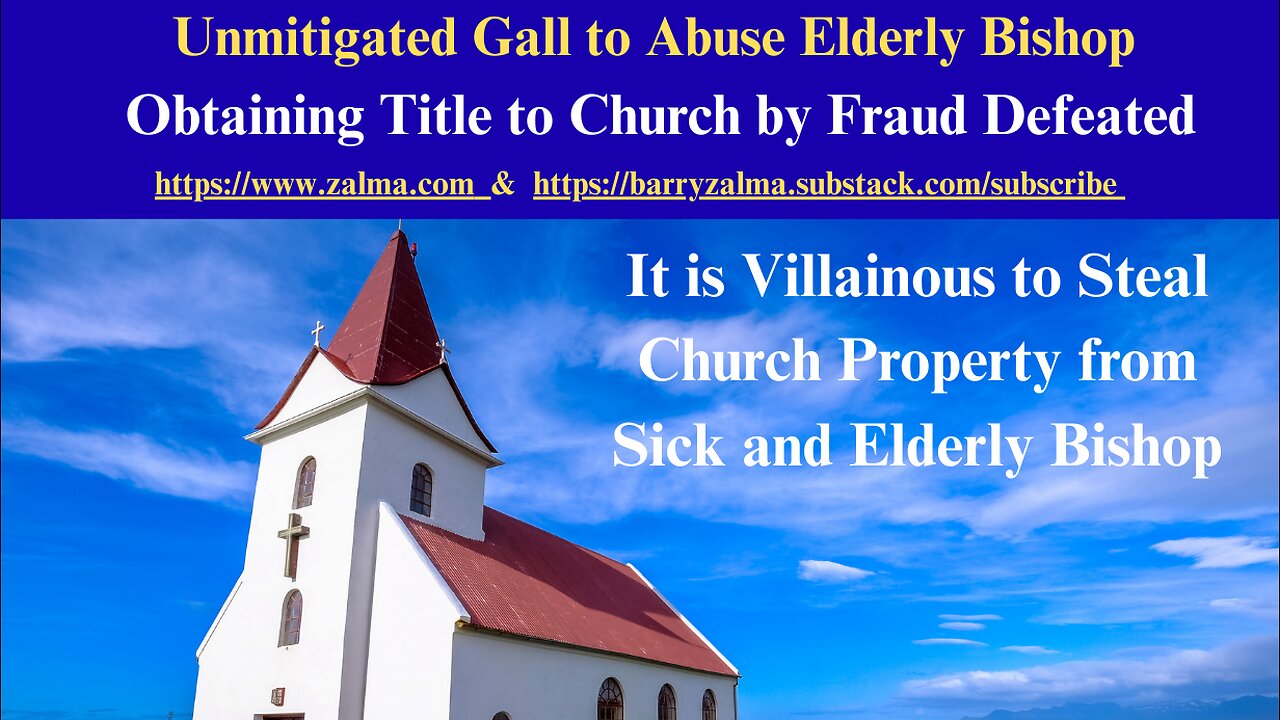
Guilty of Money Laundering Scheme
Post 5238
See the video at https://lnkd.in/gqh7V46x and at https://lnkd.in/gmE-zrDC and at https://zalma.com/blog plus more than 5200 posts.
Prison Sentence for Fraud Must be Limited to the Fraud in Which the Defendant Participated
In United States v. Stephen O. Anagor, No. 2:24-CR-00019-DCLC-CRW (E.D. Tenn., Nov. 26, 2025) by Judge Clifton L. Corker the government sought to increase the defendant’s sentence because his co-conspirators added a fraudulent FBI scam that resulted in the victim’s suicide. Anagor sought a lower sentence because he was only involved in part of the fraud.
Charges & Plea
Defendant, a U.S. Army soldier pled guilty on June 11, 2025 to Conspiracy to Commit Mail and Wire Fraud, Aiding and Abetting Aggravated Stalking Resulting in Death and Aiding and Abetting Aggravated Identity Theft that was part of a larger 38-count superseding indictment against Anagor and co-defendants Chinagorom Onwumere and Salma Abdalkareem for an international Nigerian-based ...
The Professional Claims Handler
Post 5219
Posted on October 31, 2025 by Barry Zalma
An Insurance claims professionals should be a person who:
Can read and understand the insurance policies issued by the insurer.
Understands the promises made by the policy.
Understand their obligation, as an insurer’s claims staff, to fulfill the promises made.
Are competent investigators.
Have empathy and recognize the difference between empathy and sympathy.
Understand medicine relating to traumatic injuries and are sufficiently versed in tort law to deal with lawyers as equals.
Understand how to repair damage to real and personal property and the value of the repairs or the property.
Understand how to negotiate a fair and reasonable settlement with the insured that is fair and reasonable to both the insured and the insurer.
How to Create Claims Professionals
To avoid fraudulent claims, claims of breach of contract, bad faith, punitive damages, unresolved losses, and to make a profit, insurers ...
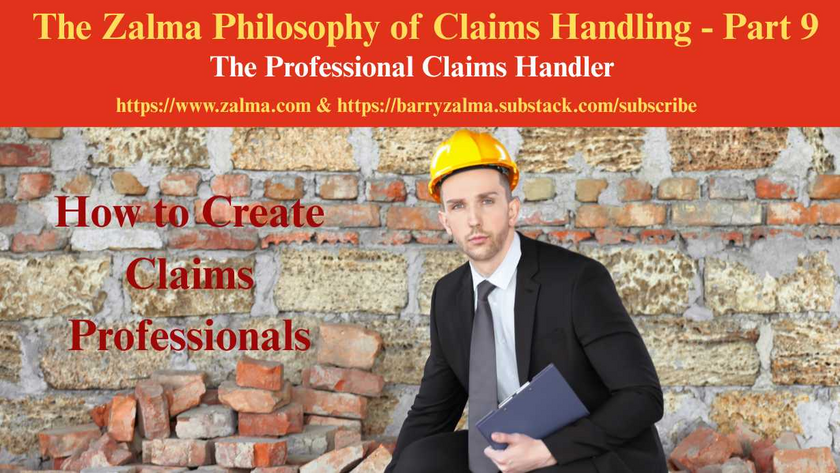
The History Behind the Creation of a Claims Handling Expert
The Insurance Industry Needs to Implement Excellence in Claims Handling or Fail
Post 5210
This is a change from my normal blog postings. It is my attempt. in more than one post, to explain the need for professional claims representatives who comply with the basic custom and practice of the insurance industry. This statement of my philosophy on claims handling starts with my history as a claims adjuster, insurance defense and coverage lawyer and insurance claims handling expert.
My Training to be an Insurance Claims Adjuster
When I was discharged from the US Army in 1967 I was hired as an insurance adjuster trainee by a professional and well respected insurance company. The insurer took a chance on me because I had been an Army Intelligence Investigator for my three years in the military and could use that training and experience to be a basis to become a professional insurance adjuster.
I was initially sat at a desk reading a text-book on insurance ...
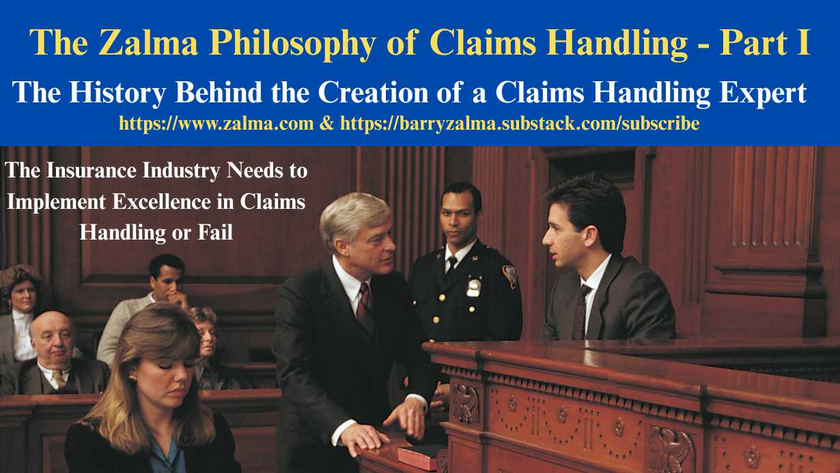
The History Behind the Creation of a Claims Handling Expert
The Insurance Industry Needs to Implement Excellence in Claims Handling or Fail
Post 5210
This is a change from my normal blog postings. It is my attempt. in more than one post, to explain the need for professional claims representatives who comply with the basic custom and practice of the insurance industry. This statement of my philosophy on claims handling starts with my history as a claims adjuster, insurance defense and coverage lawyer and insurance claims handling expert.
My Training to be an Insurance Claims Adjuster
When I was discharged from the US Army in 1967 I was hired as an insurance adjuster trainee by a professional and well respected insurance company. The insurer took a chance on me because I had been an Army Intelligence Investigator for my three years in the military and could use that training and experience to be a basis to become a professional insurance adjuster.
I was initially sat at a desk reading a text-book on insurance ...
